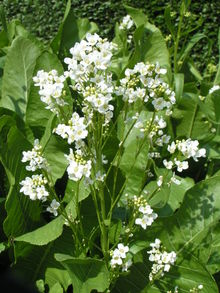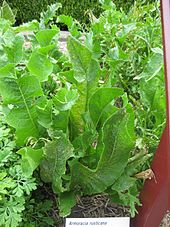 |
|
|
|
|
| Cuisines | Herbal | Spice | Curry | Yeast | Recipe | ||||||
|
Horseradish Horseradish (Armoracia rusticana, syn. Cochlearia armoracia) is a perennial plant of the Brassicaceae family, which also includes mustard, wasabi, broccoli, and cabbages. The plant is probably native to south eastern Europe and western Asia, but is popular around the world today. It grows up to 1.5 metres (5 feet) tall and is mainly cultivated for its large, white, tapered root. The intact horseradish root has hardly any aroma. When cut or grated, however, enzymes from the damaged plant cells break down sinigrin (a glucosinolate) to produce allyl isothiocyanate (mustard oil), which irritates the sinuses and eyes. Once grated, if not used immediately or mixed in vinegar, the root darkens, loses its pungency, and becomes unpleasantly bitter when exposed to air and heat. CultivationHorseradish is perennial in hardiness zones 2–9 and can be grown as an annual in other zones, though not as successfully as in zones with both a long growing season and winter temperatures cold enough to ensure plant dormancy. After the first frost in the autumn kills the leaves, the root is dug and divided. The main root is harvested and one or more large offshoots of the main root are replanted to produce next year's crop. Horseradish left undisturbed in the garden spreads via underground shoots and can become invasive. Older roots left in the ground become woody, after which they are no longer culinarily useful, although older plants can be dug and re-divided to start new plants. Culinary uses Cooks use the terms "horseradish" or "prepared horseradish" to refer to the grated root of the horseradish plant mixed with vinegar. Prepared horseradish is white to creamy-beige in colour. It will keep for months refrigerated but eventually will start to darken, indicating it is losing flavour and should be replaced. The leaves of the plant, while edible, are not commonly eaten, and are referred to as "horseradish greens". Horseradish sauceHorseradish sauce made from grated horseradish root, vinegar and cream is a popular condiment in the United Kingdom and in Poland. In the UK it is usually served with roast beef, often as part of a traditional Sunday roast, but can be used in a number of other dishes also, including sandwiches or salads. A variation of horseradish sauce, which in some cases may substitute the vinegar with other products like lemon juice or citric acid, is known in Germany as Sahnemeerrettich. Also popular in the UK is Tewkesbury mustard, a blend of mustard and grated horseradish originally created in medieval times and mentioned by Shakespeare (Falstaff says: "his wit's as thick as Tewkesbury Mustard" in Henry IV Part II). A very similar mustard, called Krensenf or Meerrettichsenf, is popular in Austria and parts of Eastern Germany. In the U.S., the term "horseradish sauce" refers to grated horseradish combined with mayonnaise or salad dressing. Prepared horseradish is a common ingredient in Bloody Mary cocktails and in cocktail sauce, and is used as a sauce or spread on meat, chicken, fish and in sandwiches. Vegetable In Central and Eastern Europe horseradish is called khreyn (in various spellings like kren) in many Slavic languages, in Austria, in parts of Germany (where the other German name Meerrettich isn't used), in North-East Italy, and in Yiddish (כריין translitered as khreyn). There are two varieties of khreyn. "Red" khreyn is mixed with red beet (beetroot) and "white" khreyn contains no beet. It is popular in Ukraine (under the name of хрін, khrin), in Poland (under the name of chrzan), in Lithuania (krienai) in the Czech Republic (křen), in Russia (хрен, khren), in Hungary (torma), in Romania (hrean), in Bulgaria (хрян, khryan), and in Slovakia (under the name of chren). Having this on the table is a part of Christian Easter and Jewish Passover tradition in Eastern and Central Europe. A variety with red beet is called ćwikła z chrzanem or simply ćwikła in Poland. In Ashkenazi European Jewish cooking beet horseradish is commonly served with Gefilte fish. Red beet with horseradish is also used as a salad served with lamb dishes at Easter called sfecla cu hrean in Transylvania and other Romanian regions. Horseradish (often grated and mixed with cream, hard-boiled eggs, or apples) is also a traditional Easter dish in Slovenia and in the adjacent Italian region of Friuli Venezia Giulia; it is used also in the other nearby Italian region of Veneto. In Croatia freshly grated horseradish is often eaten with boiled ham or beef. In Serbia ren is an essential condiment with cooked meat and freshly roasted suckling pig. Horseradish is also used as a main ingredient for soups. In the Polish region of Silesia, horseradish soup is a common Easter Day dish. Even in Japan, horseradish dyed green is often substituted for the more expensive wasabi traditionally served with sushi. The Japanese botanical name for horseradish is seiyōwasabi (セイヨウワサビ, 西洋山葵?), or "Western wasabi". Horseradish contains two glucosinolates, sinigrin and gluconasturtiin, which are responsible for its pungent taste. Nutritional valueHorseradish contains potassium, calcium, magnesium and phosphorus, as well as volatile oils, such as mustard oil (which has antibacterial properties due to the antibacterial mechanism of allyl isothiocyanate). Fresh, the plant contains average 79.31 mg of vitamin C per 100 g of raw horseradish. Research applicationsThe enzyme horseradish peroxidase, found in the plant, is used extensively in molecular biology for antibody detection, among other things. It is becoming increasingly important in biochemical research fields. Horseradish peroxidase (HRP) is widely used in research for immunohistochemistry labelling of tissue sections, e.g. in biopsies of subjects suspected to have cancer. Usually many molecules of the enzyme are covalently bound to an antibody of preferred specification for some other antibody that recognizes a specific biomarker expressed in cells that the tissue sections contain. The HRP will convert 3,3-diaminobenzidine (DAB), that is next added to the sections, to a yellowish brown insoluble compound. This compound is then visible in a photon or electron microscope. For more information see immunohistochemistry. Medicinal usesKnown to have diuretic properties, the roots have been used to treat various minor health problems, including urinary tract infections, bronchitis, sinus congestion, ingrowing toenails and coughs. Compounds found in horseradish have been found to kill some bacterial strains. |











